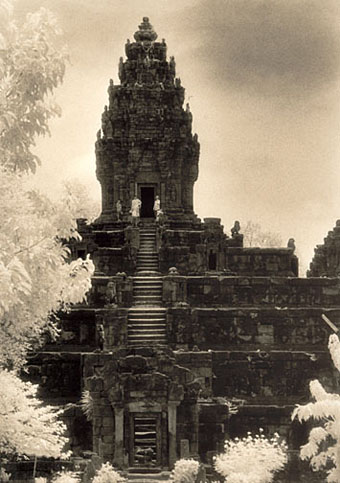The Temple of Bakong (2001).
The temples and ruins of Angkor Wat and Angkor Thom are effortlessly photogenic, so much so it seems impossible to take a bad picture of them. John McDermott’s photographs are especially fine, not least because he’s used infra-red film which always gives foliage a peculiar luminous appearance. Simon Marsden is the big populariser of this technique with his many photographs of ruins in Britain and Ireland.
Previously on { feuilleton }
• Adolph Sutro’s Gingerbread Palace
• The Jantar Mantar
• Hungarian water towers
• Karel Plicka’s views of Prague
• Atget’s Paris


That old Cambodian architecture reminds me somewhat of ancient Indian. I like the former better though, definitely one of the coolest styles of architecture as far as I am concerned. If only they’d shot a movie akin to Onibaba in an environment such as this.
Indian temple architecture seems to blend into other styles like Nepalese and Cambodian. And vice versa. I’m not sure why there isn’t much like this in cinema. Closest thing I can think of is Kurtz’s compound at the end of Apocalypse Now. For many years I suppose the place was difficult to reach and then there was the turmoil in the Seventies with the Khmer Rouge who used to use the statues for target practice. Angkor is a World Heritage site now and so subject to protection.
Of course you’re forgetting the Thai monastery in that wonderful video game adaptation, Mortal Kombat. What a powerful epic that was.
Well, Angkor was originally a Hindu temple, if I recall correctly, so the similarities with India are more than just architectural.
For Angkor on the big screen, look no further than the first Tomb Raider movie. Or, if you’d prefer (and I’d imagine you would), Wong Kar Wai’s In the Mood for Love
I lost track after Wong Kar Wai after his early HK films so I didn’t know about that. Jon Hassell, who I work with on and off, has some music in his latest one, My Blueberry Nights.